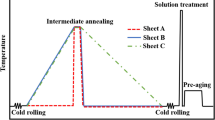Abstract
Weight reduction plays an important role in reducing fuel and emissions, and the heat-treatable 6016 aluminum alloy exhibits excellent application prospect in automobile lightweight. In this paper, ingot with constant Mg/Si ratio and decreased Mg and Si contents was obtained. Both the microstructure and the texture of 6016 aluminum alloy plate designed with different alloy compositions at the top/bottom were systematically investigated by electron backscatter diffraction technology (EBSD) measurement, as well as the room-temperature mechanical properties at the different positions with composition gradient. The results indicate that as Mg and Si contents increase, the grain size decreases, improving the cube texture with recrystallization and weakening the S texture. The strength of 6016 aluminum alloy decreases with lower Mg and Si contents.
Graphic abstract









Similar content being viewed by others
References
Guo RC, Wu N, Zhang GR. New materials for auto-body lightweight applications. Adv Mater Res. 2012;341–342(1662–8985):226.
Cole GS, Sherman AM. Light weight materials for automotive application. Mater Charact. 1995;35(1):3.
Chen T, Liu Z, Liu XM, Chen ZP. Solidified microstructure of semisolid A356-Ce alloy with two-way intermittent electromagnetic stirr. Chin J Rare Met. 2018;42(1):29.
Xu XJ, Yang F, Zhao JJ, Zhu JX, Ding Q, Wang CS. Microstructure and mechanical properties of ultrahigh strength aluminum alloy extrusion materials with different heating. Rates Solid Solut Time. 2018;42(3):238.
Zhang WM, Ji H, Ma TD, Liu YQ, Fan JZ, Fan ZG. Corrosion behaviors of 15% SiCp/2009Al composite in 3.5% NaCl solution. Chin J Rare Met. 2018;42(5):516.
Wang J, Luo BH, Bai ZH, Gao Y, Zheng YY, Ren ZW. Microstructures and properties of Al-Mg-Si casting alloy with different Mg/Si ratios. Chin J Rare Met. 2018;42(7):681.
Guo YC, Dong XB, Li JP, Xia F, Yang W, Bai YP. Solidification and microstructure of Al-Si piston alloy by melt ultrasonic treatment. Chin J Rare Met. 2018;42(7):731.
Guo C, Li BM, Zhang HT, Cui JZ. Research Status And Development Trend Of High-Strength And Corrosion-Resistant 5xxx series aluminum alloy. Chin J Rare Met. 2018;42(8):878.
Birol Y. Pre-aging to improve bake hardening in a twin-roll cast Al–Mg–Si alloy. Mater Sci Eng A. 2005;391(1–2):175.
Lee DH, Park JH, Nam SW. Enhancement of mechanical properties of Al–Mg–Si alloys by means of manganese dispersoids. Mater Technol. 1999;15(4):450.
Ewdards GA, Stiller K, DunloP GL. The precipitation sequence in Al-Mg-Si alloys. Acta Mater. 1998;46(11):3893.
Li Y, Chen L, Tang J. Effects of asymmetric feeder on microstructure and mechanical properties of high strength Al-Zn-Mg alloy by hot extrusion. J Alloys Compd. 2018;749(15):293.
Liu T, Mao WM, Feng HP. Measurement of integral texture of hot rolled aluminium sheet by X-ray transmission method. Phys Exam Test. 2005;23(4):11.
Vatne HE, Shahani R, Nes E. Deformation of cube-oriented grains and formation of recrystallized cube grains in a hot deformed commercial AlMgMn aluminium alloy. Acta Mater. 1996;44(11):4447.
Engler O, Jürgen H. Texture control by thermomechanical processing of AA6xxx Al–Mg–Si sheet alloys for automotive applications—a review. Mater Sci Eng A. 2002;336(1–2):249.
Zhang JX, Zhang L, Liu YT. Microstructure and texture evolution of 6016 aluminum alloy during hot compressing deformation. Rare Met Mater Eng. 2014;23(4):404.
Pogatscher S, Antrekowitsch H, Uggowitzer PJ. Interdependent effect of chemical composition and thermal history on artificial aging of AA6061. Acta Mater. 2012;60(15):5545.
Miao WF, Laughlin DE. Effects of Cu content and preaging on precipitation characteristics in aluminum alloy 6022. Metall Mater Trans. 2000;31(2):361.
Svenningsen G, Larsen MH, Nordlien JH. Effect of high temperature heat treatment on intergranular corrosion of AlMgSi(Cu) model alloy. Corros Sci. 2006;48(1):258.
Ni PX, Zuo XR, Li ZM. Effect of trace elements on microstructure and properties of as-cast 7005 aluminum alloy. Trans Mater Heat Treat. 2008;29(03):94.
Yuan W, Liang Z. Effect of Zr addition on properties of Al–Mg–Si aluminum alloy used for all aluminum alloy conductor. Mater Des. 2011;32(8–9):4195.
Zhong H, Rometsch P, Estrin Y. Effect of alloy composition and heat treatment on mechanical performance of 6xxx aluminum alloys. Trans Nonferr Met Soc. 2014;24(7):2174.
Zhang YH, Sun MY, Tang GP, Chen JM, Huang SK. Microstructure and martensitic transformation of cast NiTiNb shape memory alloy with different cooling gradient. Chin J Rare Met. 2018;42(11):1121.
Wu XP, Zhang BT, Peng C. Preparation of CeF3 optical coating material by temperature gradient method. Chin J Rare Met. 2018;42(12):1287.
Sengupta J, Shin HJ, Thomas BG, Kim SH. Micrograph evidence of meniscus solidification and sub-surface microstructure evolution in continuous-cast ultra-low carbon steels. Acta Mater. 2006;54(4):1165.
Založnik Miha, Šarler Božidar. Modeling of macrosegregation in direct-chill casting of aluminum alloys: estimating the influence of casting parameters. Mater Sci Eng A. 2005;413–414(15):85.
Dantzig JA. Modeling solidification processes using FIDAP. Cryst Res Technol. 1999;34(4):4.
Mahmoudi J, Vynnycky M, Fredriksson H. Modelling of fluid flow, heat transfer and solidification in the strip casting of a copper base alloy (III). Solidification—a theoretical study. Scand J Metall. 2001;30(3):136.
Friedrich J, Dagner J, Hainkel M, Müller G. Numerical modeling of crystal growth and solidification experiments carried out under microgravity conditions. Cryst Res Technol. 2003;38(7–8):726.
Zhang Z, Xun J, Shi L. Study on multiple electromagnetic continuous casting of aluminum alloy. J Mater Sci Technol. 2006;22(4):437.
Zhang ZF, Xu J, Tian ZF, Shi LK. The continuous casting of a semisolid aluminum alloy billet with a multiple magnetic field imposed. J Ceram Process Res. 2006;7(2):152.
Acknowledgements
This study was financially supported by the National Key Research and Development Program of China (No. 2016YFB0300901), the National Natural Science Foundation of China (Nos. U1708251 and U1608252), Liaoning Revitalization Talents Program (No. XLYC1807027), the Fundamental Research Funds for the Central Universities (No. N180905010) and JMRH Program (No. 2020JH2/10700003).
Author information
Authors and Affiliations
Corresponding author
Rights and permissions
About this article
Cite this article
Wang, XJ., Sun, W., Chen, JF. et al. Microstructures and properties of 6016 aluminum alloy with gradient composition. Rare Met. 40, 2154–2159 (2021). https://doi.org/10.1007/s12598-020-01515-0
Received:
Revised:
Accepted:
Published:
Issue Date:
DOI: https://doi.org/10.1007/s12598-020-01515-0




